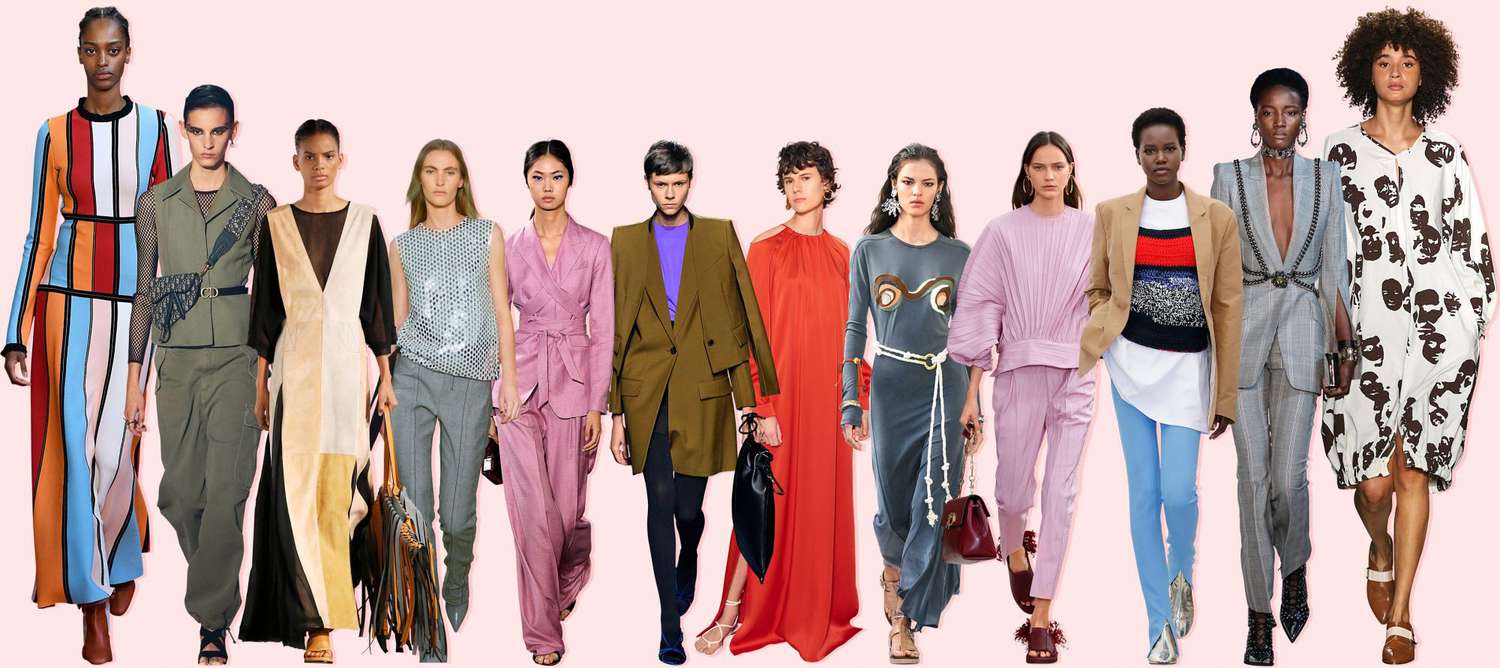Is Branded Clothing Really Better Because of the Fabric?
Is Branded Clothing Really Better Because of the Fabric?
Blog Article
Comprehending Apparel: The Importance of Fabric Options in Your Closet
The selection of textile in clothing plays an essential role in both aesthetic appeals and capability. Various materials offer varying levels of comfort, toughness, and breathability, straight affecting the user's experience. Recognizing these nuances can improve one's closet markedly. Yet, many overlook how these options can impact not just personal style, but likewise sustainability. What material choices could redefine your closet and align it with both design and duty?
The Duty of Textile in vogue and Capability

Common Fabric Kinds and Their Features
When choosing clothes, understanding the features of typical fabric types is crucial for making informed choices. Cotton, a widely-used natural fiber, is understood for its softness, versatility, and breathability, making it ideal for laid-back wear and everyday garments. Linen, one more natural alternative, boasts excellent moisture-wicking homes and an unique structure, ideal for warm climates.Wool, frequently favored for its warmth and resilience, varies in fineness; merino woollen is soft versus the skin, while coarser types are made use of for outerwear. Artificial materials like polyester and nylon use sturdiness and resistance to wrinkles, making them preferred for activewear and travel garments. Blends, which integrate all-natural and artificial fibers, can enhance performance while maintaining convenience. By identifying these material features, people can select apparel that straightens with their way of life and visual choices.
Breathability and Convenience: Selecting the Right Fabrics for Different Environments
Selecting the appropriate materials for various environments can significantly boost comfort and general wearability. Breathable products are crucial in warm environments, as they allow air blood circulation and wetness evaporation. Fabrics such as cotton, bed linen, and moisture-wicking synthetics successfully attract sweat far from the body, maintaining the wearer cool and completely dry. Conversely, in cooler climates, thicker materials like woollen or fleece supply insulation while preserving breathability, making certain warmth without overheating.Additionally, the selection of material weight plays an essential function; lightweight textiles are better for summertime, whereas larger options are fit for winter wear. Recognizing the distinct properties of each textile allows people to clothe properly for differing weather conditions. Inevitably, selecting breathable and comfy fabrics customized to details climates can substantially enhance day-to-day comfort and boost the total experience of using clothes.
Durability and Care: Just How Material Influences Long Life of Your Closet
Choosing the right materials can substantially impact the durability and care needs of a wardrobe. Fabrics such as cotton and polyester are understood for their resilience and simplicity of upkeep, making them optimal for day-to-day wear. On the other hand, delicate materials like silk and lace call for even more cautious handling and specialized cleansing methods, which can enhance the time and effort needed for care. Branded Clothing.Durability is also influenced by the textile's weave and coating; securely woven fabrics often tend to resist damage better than loosely woven choices. Additionally, synthetic blends typically supply improved longevity, incorporating the very best qualities of several fibers.Understanding the care guidelines for each and every fabric is crucial, as incorrect washing or drying can bring about early wear. Inevitably, selecting resilient materials can bring about a longer-lasting closet, minimizing the frequency of substitutes and adding to a much more lasting style choice
The Influence of Textile on Fit and Shape

Lasting Textile Choices: Making Eco-Friendly Decisions
The impact of textile expands past fit and shape to include environmental factors, triggering a growing rate of interest in sustainable fabric selections. Eco-friendly textiles, such as organic cotton, hemp, and Tencel, are getting traction amongst customers that focus on sustainability in their wardrobes. These materials are typically created with fewer chemicals and water, reducing their ecological footprint.Additionally, recycled textiles, made from post-consumer waste, supply an ingenious option to the textile industry's air pollution problem. Brands progressively embrace openness in their sourcing approaches, enabling customers to make enlightened decisions about their purchases.Choosing lasting materials not only sustains ethical techniques but additionally encourages the style industry to embrace more liable production approaches. As awareness of ecological issues rises, people are urged to show on the long-lasting effect of their fabric choices, promoting a motion in the direction of a more environmentally conscious and lasting method to fashion.
Raising Style: Just How Material Can Change an Attire
While many may concentrate on shade and cut when selecting an attire, the choice of textile plays an important function in elevating style and improving general appearance. Various products communicate distinctive moods and messages; as an example, silk radiates deluxe and refinement, while denim offers an informal, relaxed vibe. The appearance and drape of a fabric can significantly alter the silhouette, with structured fabrics offering a refined appearance and softer ones developing a more fluid, kicked back aesthetic.Moreover, the weight of the material affects wearability throughout periods. Light-weight materials like her explanation linen and cotton are excellent for summer, while much heavier products such as woollen and velvet offer heat and elegance in chillier months. Comprehending material residential properties, such as breathability and stretch, additionally encourages individuals to make educated options that boost convenience without compromising design. Inevitably, the right fabric can change a clothing from average to extraordinary, making it an essential factor to consider in any type of wardrobe.
Often Asked Concerns
Exactly how Do I Recognize the Textile Web Content of My Clothing?
To recognize material content, one can examine treatment tags, conduct burn tests for fiber identification, or speak with fabric examples. These approaches help separate products, ensuring educated selections for garments care and maintenance in daily learn the facts here now wear.
Can Material Choice Affect My State Of Mind or Confidence?
Material choice can greatly affect a person's state of mind and confidence. Branded Clothing. Certain products may evoke sensations of comfort or style, while others can feel restrictive or uncomplimentary, inevitably affecting self-perception and emotional well-being throughout the day
What Fabrics Are Ideal for Sensitive Skin?
For individuals with delicate skin, natural textiles like linen, cotton, and bamboo are often recommended. These products are breathable, hypoallergenic, and much less most likely to create irritability, making them ideal selections for comfort and skin health.
Exactly how Do I Correctly Wash and Take Care Of Different Fabrics?
To effectively wash and care for various materials, one should take into consideration each product's details demands, including temperature level setups, cleaning agents, and drying out approaches, ensuring longevity and maintaining the material's original qualities for ideal usage.
Exist Details Fabrics for Athletic or Performance Put On?
Sports or efficiency wear usually utilizes materials such as polyester, spandex, and nylon. These products are designed for moisture-wicking, breathability, and versatility, improving movement and comfort throughout physical activities while providing resilience and support. On the other hand, in colder environments, thicker fabrics like woollen or fleece supply insulation while preserving breathability, making certain heat without overheating.Additionally, the option of textile weight plays an important role; light-weight textiles are preferable for summer, whereas much heavier alternatives are fit for winter season wear. In contrast, delicate products like silk and lace require more cautious handling and specialized cleansing techniques, which can raise the time and effort required for care.Durability is additionally affected by the fabric's weave and coating; securely woven materials often tend to withstand wear and tear far better than loosely woven choices. In comparison, inflexible fabrics can limit motion yet give a classic, refined look.Moreover, the density and structure of the fabric can affect the aesthetic assumption of body form. The effect of fabric prolongs beyond fit and silhouette to encompass environmental elements, prompting an expanding rate of interest in sustainable fabric choices. The appearance and drape of a material can drastically alter the silhouette, with structured textiles providing a polished appearance and softer ones developing an extra fluid, relaxed aesthetic.Moreover, the weight of the material affects wearability throughout seasons.
Report this page